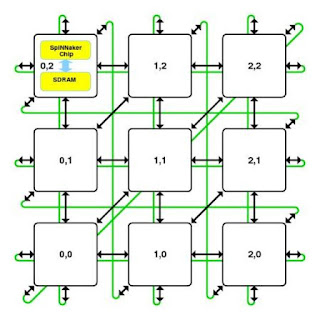On November 2, researchers at the University of Manchester launched the most powerful supercomputer whose architecture simulates the human brain.
It employs a million ARM9 cores that can handle 200 trillion operations per second. Computer designed for 20 years, and another 10 years collected. The construction work started in 2006, and the total amount spent on the project was £ 15,000,000.
How does it work?
The main difficulty of such a project is to create iron, which can cope with a multitude of parallel processes in much the same way as a biological brain does. For example, the human brain consists of approximately 100 billion neurons. The number of connections between these neurons is astronomical. The researchers plan to create a model of one billion neurons using their supercomputer, which will be processed in real time. Despite the fact that this is only one percent of the human brain - a step for computer science is huge. So far, no supercomputer could cope with this task.
The main decisions in the supercomputer are related to the architecture of iron . It is called SpiNNaker (Spiking Neural Network Architecture). In it, a million nuclei is divided into 57 thousand nodes. Each has 18 cores and 128 megabytes of SDRAM memory, which is located separately from the matrix with chips. There are several ways to transfer information between the cores, but the main one is in packets of 5–9 kilobytes.
All nodes are connected to an asynchronous infrastructure. Mobile processors and memory are chosen for energy reasons - in such a powerful system it is one of the main resources for which it had to sacrifice performance.
The principles of interaction between the processors relied on neurobiology. In conventional computers, the amount of data sent is much higher, because they contain information about how and where the system should deliver the information.
In the SpiNNaker architecture, this was avoided. Data packets contain only information about the source, and the infrastructure sends them to the destination. As the Motherboard edition explains , such an infrastructure is the same as the work of mail without post offices - everyone has a personal postman who himself knows what address to deliver the parcel to.
Steve Furber, a computer engineering professor and project researcher, says: “SpiNNaker completely reinvents the way computers work. We managed to create a machine that works more like a brain than a computer, and this is just incredible. ”
What will be used for
Now the computer will be used for academic and scientific research. For example, scientists have already recreated the area of the cerebral cortex consisting of 80 thousand neurons that are responsible for processing sensory information. This model helped the robot to process video information in real time in order to navigate difficult terrain.




Post a Comment
Post a Comment